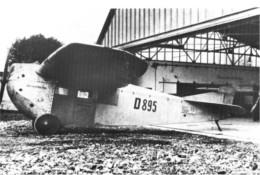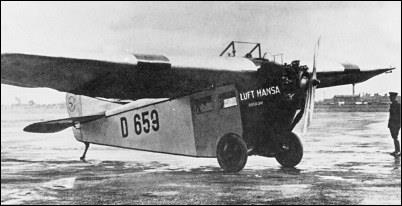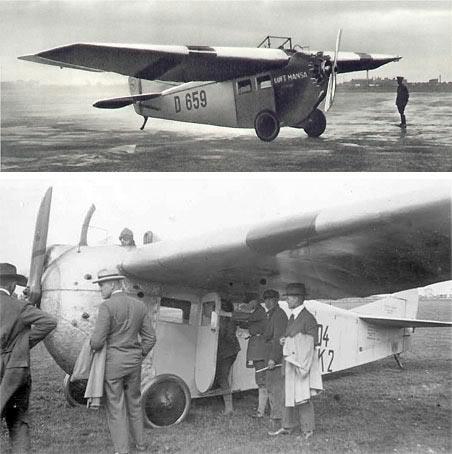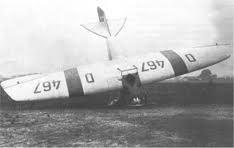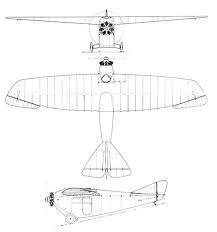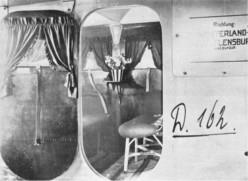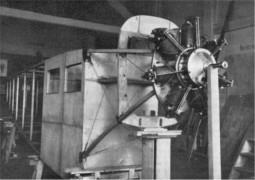With the success of their earlier designs Focke and Wulf formed the Focke-Wulf company in 1924 and their first design was an all-wood three/four passenger airliner or light transport the A.16. First flown by Georg Wulf on 23 June 1924, at least 20 aircraft were built.
The A.16 was a high-wing monoplane of conventional configuration. The wing used a thick airfoil. The pilot sat in an open cockpit above the wing while the passengers were carried in the enclosed fuselage below. The tailskid undercarriage featured large wheels mounted on each side of the fuselage.
A 16c 1 + 3/4 seat airliner
A 16d 1 + 3/4 seat airliner
Version ;
a) Wider body , the engine moved 100 mm to the right from center line to give place for the pilot . The tank was placed in the nose that was compensated with a longer fuselage
b) two built
c) different radial engines, placed in the center
d) same fuselage as the a , 5 a rebuilt to this version - total 9 d:s
Flight Jan. 1925
THE FOCKE-WULF TYPE A. 16
An Interesting German Commercial Aeroplane
THE question" has"frequently been argued whether or not it is possible to^apply the principles governing light aeroplane design to larger machines-in other words, whether it is possible to build an enlarged version of a light 'plane and get the same relative efficiency as regards performance and useful load. It is generally maintained that this is not possible because the structure weight of an aeroplane increases as the cube of the dimensions while the area increases only as the square. To this argument-which is, of course, perfectly sound from a theoretical point of view-the answer is sometimes advanced that the rate at which the percentage of useful or paying load decreases with &ize can, in practice, be diminished by changes in structural design, i.e., by not making the larger machine geometrically similar to the smaller in all its structural details.
Sometimes it is found that in a large machine it is possible to use built-up components in place of solid ones, and thus effect a saving in weight. If this is done wherever possible the result is that the structure weight does not increase quite as the cube, although probably more rapidly than the square of the dimensions.
In view of the arguments, sometimes rather heated, that have centred around this subject, we have thought it of interest to give an illustrated description of a German commercial aeroplane recently prodoiced, in which, to a very large extent, the features which characterise many modern light 'planes have been incorporated, and which, in spite of its low engine four persons at a very good speed. This machine is the Focke-Wulf A. 16, fitted with a 75 h.p. Siemens radial air-cooled engine. The A. 16 carries three passengers in addition to the pilot, so that the power expenditure is but 25 h.p. per paying passenger. In spite of this fact, the top speed is 135 km./h. (84-4 m.p.h.), so that there can be little doubt as to the efficiency of the design. The A. 16 was designed and built by the Focke-Wulf Flugzeugbau, A.G., of 21/22 Loeningstrasse, Bremen, a firm of recent date, having been established in January of 1924.
As the accompanying photographs and general arrangement drawings will show, the Focke-Wulf A. 16 is a cantilever high- wing monoplane in which every care has been taken to suppress all external bracing, not only of the wing structure, but of the tail members and undercarriage. The lines, although clean, are not particularly smooth, especially in the neighbourhood of the nose, where sudden changes of direction occur. This is, of course, due to the necessity of providing reasonable cabin space on the one hand and reducing the cross-sectional area immediately aft of the engine on the other. The steep slope of the " breast " does not, however, appear to have affected the efficiency to any great extent, for which possibly the fact that this portion is covered with a fairly rounded aluminium cowling is responsible. In other words, if one were to draw " waterlines " through the fuselage these would show a fairly rounded form in front.
On top of the fuselage there is a central hump which conforms to the upper curvature of the wing section, and so there is no sudden discontinuity in the region of maximum air pressure, if one excepts the coaming around the pilot's cockpit, which is placed immediately ahead of the front wing spar. The wing is placed wholly on top of the fuselage structure, and the centre portion forms, in fact, part of the cabin, giving more than 6 ft. of head room.
The wing section used appears to be one of the Schoukowsky family (it is erroneously shown with flat bottom camber in the side elevation of the general arrangement drawings), and the wing tapers both in chord and thickness from root to tip.
In order to simplify construction the spars run parallel throughout the span, more or less forming a rectangular section box. Wood is the material employed, not only in the wing, but throughout the machine with a very few exceptions. The wing is covered with fabric, while the fuselage is of the flat-sided monocoque type with three-ply covering. The bottom of the fuselage is flat, but the top has a deck fairing extending aft to the tail plane.
Over the central portion of the fuselage, where the cabin is situated, the walls are of double-planked three-ply, with the structural members enclosed between the two plankings, thus leaving the cabin walls perfectly smooth. The interior is finished in mahogany, and the three seats for the passengers are comfortably upholstered. Access to the cabin is through a door on the port side, and owing to the design of the machine the passengers can step into the cabin direct from the ground without the use of steps, the height of the door-step above the ground being only about a foot. Two windows in each side give an unobstructed view in most directions, as the wing is placed above the fuselage.
As already mentioned, the pilot's cockpit is placed ahead of the wing, and owing to his proximity to the engine, combined with the downward slope of the cowling, his view is particularly good. In fact, it would be almost impossible to think of any way of improving the view. The small radial engine obstructs it to a very small extent only, and the narrow width of the fuselage just aft of the engine enables the pilot easily to look over either side. The one objection to this placing of the pilot, i.e., the possible risk of injury in case the machine turns over, seems to be met by the presence, immediately behind the pilot's head, of the very substantial and deep front wing spar.
The 75 h.p. Siemens-Halske radial air-cooled engine is mounted on a steel engine plate attached to stout ash frames forming the forward extension of the longerons. A fireproof bulkhead is interposed between the engine and the cockpit and cabin, and as the petrol tank, with a capacity for four hours at full throttle, is placed out in the starboard wing, the fire
risk should be very small. It is claimed that this tank position not only enables direct gravity feed to be used, but that the weight of tank and fuel serves to counteract the engine torque as well.
The undercarriage is of the wing-stump, cantilever type, and is built, in the Focke-Wulf A. 16, injthe form'of^a box inside which the divided axle rests. The outside of the box is streamlined with three-ply. The whole undercarriage is built up as a unit and can be detached from the machine by undoing six bolts. A somewhat similar arrangement is employed in the case of the wing and tail, both of wMch can be removed as complete units by undoing a few bolts.
Controls are of the usual type, but a refinement has beeii introduced by the employment everywhere of ball bearings. This, it may be recollected, is now a feature of all de Havilland machines, where the use of ball bearings has been found to result in a marked increase in the lightness of the controls. In the Focke-Wulf A. 16 only a small portion of the control cables is exposed, the greater portion being taken inside the fuselage In order to facilitate inspection of control cables, etc., the deck faring of the fuselage is easily detachable, and when it is removed, the cables and fuselage structure can be readily examined. • t
During the official test flights at Adlershof (which corresponds roughly to our Martlesham or Farnborough) the Focke-Wulf A. 16 attained a top speed of 135 km./h. (84-4 m.p.h). while the rate of climb was 0-92 metre per second (181 ft'./min.) at a height of 3,000 ft This is not. of course, a very spectacular performance, but in view of the relatively heavy loading is about all that could be expected. These figures, by the way, relate to the machine fully loaded, with pilot, three passengers and fuel for four hours. It is stated that the stalling speed is about 60 km./h. (2>1\ m.p.h.). The machine takes off in about 160 yards and pulls up in about 55 yards, once the wheels have touched. It has, however, the same characteristics as light 'planes in landing, i.e. it " floats " along a considerable distance before settling down.
Following are the main data of the Focke-Wulf A. 16, the overall dimensions being given on the G.A. drawings : Wing area, 291 sq. ft. Weight empty, 570 kg. (1,254 lbs.) ; useful load (pilot, three passengers and four hours' fuel), 400 kg. (880 lbs). Total loaded weight, 970 kg. (2,134 lbs.). Power loading, 28-5 lbs./h.p. ; wing loading, 7-33 lbs./sq. ft.). Duration 4 hours. Range approximately 550 km. (350 miles). It is of interest to note that the ratio of useful load to gross weight is \\\ per cent. Looked at in another way, for a useful range of, say, 300 miles at 80 m.p.h., the paying load (i.e., 3 passengers) is 6-7 lbs./h.p.
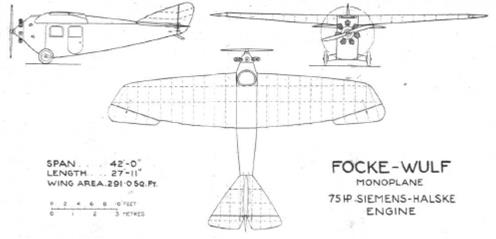

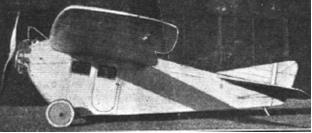
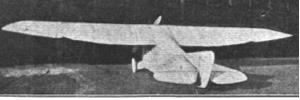
Flight maj 1925
Focke-Wulf Flugzeugbau
It is now some two years ago that a new German aircraft firm somewhat startled the world by producing a commercial machine of an aerodynamic efficiency approaching that of gliders, or, at any rate, of the most efficient light 'planes
This machine, the A. 16, was designed as a small commercial machine, and that it is efficient will be gathered when we say that with an engine of 75 h.p. it carries a pilot and three passengers ; in other words, a power expenditure of about 19 h.p. per occupant. Even at that the performance is quite good, the topspeed being 135-140 km./h. (84-87 m.p.h.). With the high-power loading it might be expected that the climb would not be particularly good, but we understand an altitude of 3,000 m. (9,800 ft.) is reached in 14 minutes, which is certainly not bad.
Just recently a modified version has been prepared which is very similar in general design to the original A. 16, but is fitted with a 100 h.p. Mercedes in place of the original 75 h.p. Siemens radial. Owing to the considerably greater weight of the Mercedes, the new type, the A. 16A, carries a not much greater useful load, but it is thought that the reliability should be considerably greater.
For the Round-Germany flight the Focke-Wulf firm has entered one machine of each type, but there will be five of their machines in the competition, as other companies have entered machines of Focke-Wulf construction. One of the machines entered by this Company will be piloted by Herr Georg Wulf himself.
WTith the exception of minor changes in detail, the construction of both types of Focke-Wrulf is the same, and the following notes, unless otherwise stated, may therefore be taken to refer to both machines. The fuselage, which is of rectangular section, is built entirely of wood, and is exceptionally deep so as to give sufficient headroom in the cabin.
Owing to the small height of the bottom of the fuselage above the ground it is possible for passengers to step right into the cabin without having to use steps. As the wing is placed on the top of the fuselage, the view from, the cabin windows is particularly unrestricted in a downward direction. The pilot's seat is above and in front of the cabin, the coaming around his cockpit being, in fact, in the leading edge of the wing.
The monoplane wing itself is built as a pure cantilever in order to reduce head resistance, and the wing section used is one of the well-known Gottingen sections. The wing is of tapered thickness as well as plan form. On top it is faired into the top of the fuselage so as to cause as little disturbance in the air flow as possible. The ailerons are not of exceptionally large size, but are stated to be very effective. The under-carriage is of very simple form, and consists of two wheels mounted on axles which are housed inside the streamline wing roots growing out of the fuselage near the bottom. Every endeavour has been made to suppress all parts which could increase head resistance, and, doubtless, this accounts in a great measure for the efficiency of the Focke-Wulf machines.
The A. 16A differs from the earlier type partly in dimensions
and partly in seating accommodation, etc. In the latest
model, the pilot sits at the side of and behind the engine. The increase in the cabin width can, if desired, be made use
of by fitting an extra seat for a fourth passenger. In the A16A there are two petrol tanks carried in the centre section of the wing, so that there is no fuel carried in the fuselage itself, a fact which should greatly reduce fire risk.
The main particulars of the Focke-Wulf A. 16 are as follows :
-Length, o.a., 8-5 m. (27 ft. 11 ins.) ; span, 13 -9 m. (45 ft. 6 ins.) ; wing area, 27 sq. m. (290 sq. ft.). Weight of machine empty, 570 kg. (1,250 lb.) ; useful load, 400 kg. (880 lb.) ; total loaded weight, 970 kg. (2,130 lb.). The speed and climb have already been given, but it may be added that the tank capacity is sufficient for about four hours, and that the range of the machine is approximately 550 km. (345 miles).
The A. 16A has the same wing span and wing area, but is slightly longer, being 9 • 1 m. (29 ft. 11 ins.). With the 100 h.p. Mercedes engine, the weight empty is 760 kg. (1,670 lb.), and the useful load, 441 kg. (970 lb.), giving a total loaded weight of 1,201 kg. (2,640 lb.). The top speed of this machine is in the neighbourhood of 150 km./h. (93 m.p.h.). To climb 2,000 m. occupies 13 mins., and the ceiling is 3,000 m. (9,800 (ft.). Duration, 3£ hours and range 500 km. (310 miles).
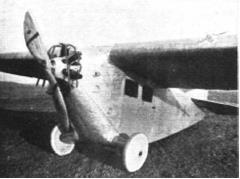
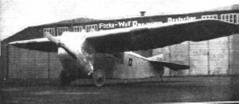
| Type |
A 16 1 + 3/4 seat airliner |
A 16a 1 + 3/4 seat airliner
|
A 16b 1 + 3/4 seat airliner
|
A 16c 1 + 3/4 seat airliner
|
A 16d 1 + 3/4 seat airliner
|
| Engine |
1 Siemens Sh 5 |
1 Daimler D1 |
1 Junkers L1 |
1 Siemens Sh 6 or Sh 12 or Sh 14 |
1 Mercedes DII |
| Dimensions |
Length 8,5 m span 13,9 m height 2,3 m wingarea 27 m2 |
Length 9,1 m span 14,0 m height 2,3 m wingarea 27 m2
|
|
|
Length 9,1 m span 14,0 m height 2,3 m wingarea 27 m2
|
| Weights |
Empty 570 kg löad 400 kg flying weight 970 kg wingloading 36 kg/m2 power loading 13 kg/hp |
Empty 750kg löad 450 kg flying weight 1200 kg
|
Empty 570 kg löad 400 kg flying weight 970 kg
|
Empty 600 kg, flying weight 1000 kg |
|
| Performance |
Max. speed 135 km/h range 550 km endurance 4 h |
Max. speed 145 km/h |
Max. speed 140 km/h |
|
Max. speed 162 km/h climb to 1000 m 6 min. to 2000 m 14 min to 3000 m 25 min. service ceiling 3800 m |
